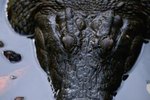
More than 280 species of turtles exist throughout the world, eating food as varied as clams, crayfish, fruit, leaves and insects -- without the aid teeth. While a human would have a difficult time cracking open a large clam using his mouth alone, whether or not he had teeth, turtles are specially adapted for biting without them.
Beaks
Most species of turtle have sharp edges along both upper and lower jaws or beaks. The muscles in the head exert hundreds of pounds of pressure, enabling a turtle to bite off chunks of vegetation or snip amphibians or carrion into bite-size pieces. The tongue moves the chunks of food to the rear of the mouth for swallowing. Snapping turtles are some of the strongest, capable of biting through a broomstick or amputating a human finger.
Lipped Turtles
Some turtle species, such as soft-shelled turtles, have soft lips instead of sharp beaks. These turtles swallow their food whole, sucking it into their mouths and swallowing using the muscles of their tongues. Some aquatic species use their tongues as bait, luring small fish or other creatures into their mouths and then closing their jaws around them before swallowing them.
References
Photo Credits
-
Jupiterimages/Photos.com/Getty Images
Writer Bio
Indulging her passion for vacation vagary through the written word on a full-time basis since 2010, travel funster Jodi Thornton-O'Connell guides readers to the unexpected, quirky, and awe-inspiring.




